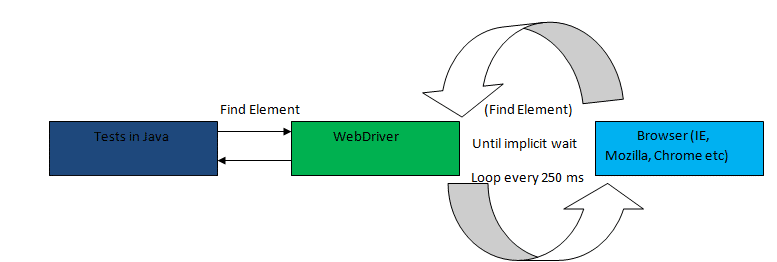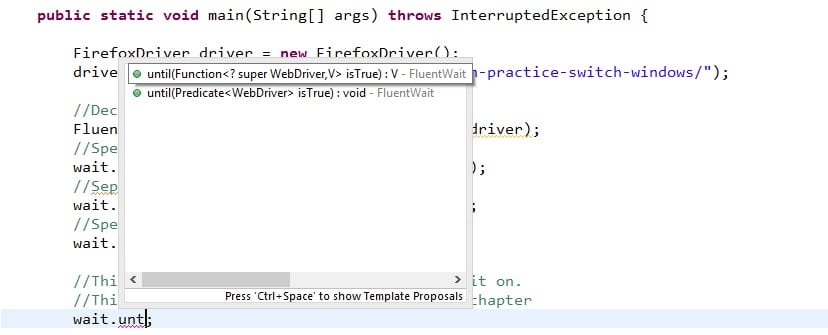To understand this chapter you have to learn the concepts discussed in the earlier WebDriver Waits chapter already. Also, it is better to learn How to Handle Ajax Wait in Selenium.
In this chapter, we will explore more on the Fluent Waits and see how we can create our own Custom Waits or Advance WebDriver Waits. A fluent wait looks like this:
//Declare and initialise a fluent wait
FluentWait wait = new FluentWait(driver);
//Specify the timout of the wait
wait.withTimeout(5000, TimeUnit.MILLISECONDS);
//Sepcify polling time
wait.pollingEvery(250, TimeUnit.MILLISECONDS);
//Specify what exceptions to ignore
wait.ignoring(NoSuchElementException.class)
//This is how we specify the condition to wait on.
//This is what we will explore more in this chapter
wait.until(ExpectedConditions.alertIsPresent());
Fluent waits are also called smart waits also. They are called smart primarily because they don't wait for the max time out, specified in the .withTimeout(5000, TimeUnit.MILLISECONDS). Instead, it waits for the time till the condition specified in .until(YourCondition) method becomes true.
A flow diagram explaining the working of Fluent wait is explained in the below diagram.

When the until method is called, following things happen in strictly this sequence
- Step 1: In this step fluent wait captures the wait start time.
- Step 2: Fluent wait checks the condition that is mentioned in the .until() method
- Step 3: If the condition is not met, a thread sleep is applied with time out of the value mentioned in the .pollingEvery(250, TimeUnit.MILLISECONDS) method call. In the example above it is of 250 milliseconds.
- Step 4: Once the thread sleep of step 3 expires, a check of start time is made with the current time. If the difference between wait start time, as captured in step 1, and the current time is less than time specified in .withTimeout(5000, TimeUnit.MILLISECONDS) then step 2 is repeated.
This process keeps on happening till the time either the time out expires or the condition comes out to be true.
In this example we have used ExpectedConditions class. This is quite a handy class and will suite most of your needs. However, at times we might need more than what is present in ExpectedConditions. If you pay close attention to the .until() method you will realize that is an overloaded function which can take two types of parameters.
- A Function()
- A Predicate()
Lets take a look at one such example. We will take a simple scenario which is present on this page http://demoqa.com/browser-windows/
Problem: On this page there is a button "Change Color" this button turns red a after a few seconds. Lets write a simple wait which can wait for the color of the button to change. Once the color has changed, click on the button.
Before we start lets just take a look at what is signature of .until() method overload.

Pay attention that .until() method can accept a Function< ? super WebDriver, V> or a Predicate;
What is a Function?
Package: com.google.common.base.Function
A Function here is a generic interface which asks you to implement the following methods - apply(F from) - equals(Object obj) Implementation of equals can be ignored and it will be picked from the base implementation.
How to define one?
Function<WebDriver, Boolean> function = new Function<WebDriver, Boolean>()
{
public Boolean apply(WebDriver arg0) {
return null;
}
};
Pay attention that we have to define the apply method ourselves. Now the important point to note here is the signature of the apply method. Method will accept a WebDriver as the input argument and will return a Boolean value. This is because of the way we have defined the Function (Function). First argument mentioned will be the input argument and the second will be the return value of the apply method.
Now implement the apply method so that it returns false in case of condition failure and return true in case of condition being met. In our case, we will return false if the color of the button is not red else we will return true. Here is the code sample
Function<WebDriver, Boolean> function = new Function<WebDriver, Boolean>()
{
public Boolean apply(WebDriver arg0) {
WebElement element = arg0.findElement(By.id("colorVar"));
String color = element.getAttribute("color");
if(color.equals("red"))
{
return true;
}
return false;
}
};
Now that we have the wait condition we can simply apply the wait condition in the FluentWait. Like this, notice that I have added some print statements to see what is happening in the code
public static void main(String[] args) throws InterruptedException {
WebDriver driver = new FirefoxDriver();
driver.get("https://demoqa.com/browser-windows/");
FluentWait<WebDriver> wait = new FluentWait<WebDriver>(driver);
wait.pollingEvery(250, TimeUnit.MILLISECONDS);
wait.withTimeout(2, TimeUnit.SECONDS);
Function<WebDriver, Boolean> function = new Function<WebDriver, Boolean>()
{
public Boolean apply(WebDriver arg0) {
WebElement element = arg0.findElement(By.id("colorVar"));
String color = element.getAttribute("color");
System.out.println("The color if the button is " + color);
if(color.equals("red"))
{
return true;
}
return false;
}
};
wait.until(function);
}
This is the output that you get on the console window: The color of the button is color: white; The color of the button is color: white; The color of the button is color: white; The color of the button is color: white; The color of the button is color: white; The color of the button is color: red;
See that the function tests for the color property of the control for around 5 times and in the last attempt it is able to find the color property to be red. This is when the wait exits.
A function can also be used to return objects instead of a Boolean value. In the case of object make sure that your implementation of apply method returns null until the time object is not found. Let's see this with the example. In the above test page, we have a new object that we added in the HTML page after every few seconds. This object has an id = target. Let's wait for this object using a fluent wait. I will directly share the code with you, hope you can understand the details by looking at it by now.
public static void main(String[] args) throws InterruptedException {
WebDriver driver = new FirefoxDriver();
driver.get("https://demoqa.com/browser-windows/");
FluentWait<WebDriver> wait = new FluentWait<WebDriver>(driver);
wait.pollingEvery(250, TimeUnit.MILLISECONDS);
wait.withTimeout(2, TimeUnit.MINUTES);
wait.ignoring(NoSuchElementException.class); //make sure that this exception is ignored
Function<WebDriver, WebElement> function = new Function<WebDriver, WebElement>()
{
public WebElement apply(WebDriver arg0) {
System.out.println("Checking for the element!!");
WebElement element = arg0.findElement(By.id("target"));
if(element != null)
{
System.out.println("Target element found");
}
return element;
}
};
wait.until(function);
}
}
What is a Predicate?
A predicate is similar to a function but it always returns a Boolean expression. You can define a predicate like this
Predicate<WebDriver> predicate = new Predicate<WebDriver>()
{
public boolean apply(WebDriver arg0) {
return false;
}
};
It's just a matter of time that you implement some condition in the apply method such that it returns true in success and false otherwise. The color-changing button can be waited on using a predicate like this
public static void main(String[] args) throws InterruptedException {
WebDriver driver = new FirefoxDriver();
driver.get("https://demoqa.com/browser-windows/");
FluentWait<WebDriver> wait = new FluentWait<WebDriver>(driver);
wait.pollingEvery(250, TimeUnit.MILLISECONDS);
wait.withTimeout(2, TimeUnit.MINUTES);
wait.ignoring(NoSuchElementException.class); //make sure that this exception is ignored
Predicate<WebDriver> predicate = new Predicate<WebDriver>()
{
public boolean apply(WebDriver arg0) {
WebElement element = arg0.findElement(By.id("colorVar"));
String color = element.getAttribute("color");
System.out.println("The color if the button is " + color);
if(color.equals("red"))
{
return true;
}
return false;
}
};
wait.until(predicate);
}













